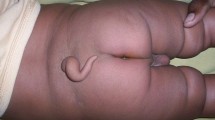Abstract
The focus of this chapter will be on the anatomic structure of the pelvis and some of the changes it experiences as it progresses with age. Particular attention will be paid to how these structures and functions relate to both the surgeon and the physiologist, and the relevance of significant changes that occur through adulthood and older age—though many of these will be addressed in specific chapters later in this text.
Access this chapter
Tax calculation will be finalised at checkout
Purchases are for personal use only
Similar content being viewed by others
References
Sadler TW, Langman J. Langman’s medical embryology. 10th ed. Philadelphia: Lippincott Williams & Wilkins; 2006.
Delaere O, Dhem A. Prenatal development of the human pelvis and acetabulum. Acta Orthop Belg. 1999;65(3):255–60.
Esses SI, Botsford DJ, Huler RJ. Surgical anatomy of the sacrum. A guide for rational screw fixation. Spine. 1991;16 Suppl 6:283–8.
Cheng JS, Song, JK. Anatomy of the Sacrum. Neurosurg Focus. 2003;15(2):25–50.
Agur AMR, Lee MJ, Boileau Grant JC. Grant’s atlas of anatomy. 10th ed. Philadelphia: Lippincott Williams & Wilkins; 1999.
Abitbol MM. Evolution of the sacrum in hominoids. Am J Phys Anthropol. 1987;74:65–81.
Roussouly P, Gollogly S, Berthonnaud E, Dimnet J. Classification of the normal variation in the sagittal alignment of the human lumbar spine and pelvis in the standing position. Spine. 2005;30(3):346–53.
Donovan DJ, Pedersen RC. Human tail with noncontiguous intraspinal lipoma and spinal cord tethering: case report and embryologic discussion. Pediatr Neurosurg. 2005;41:35–40.
O’Rahilly R, Muller F, Meyer DB. The human vertebral column at the end of the embryonic period proper. 4. The sacrococcygeal region. J Anat. 1990;168:95–111.
Le Double A. Traite’ des variations de la colonne verte’brale del’homme. Paris: Vigot fre’res; 1912. p. 501.
Woon JT, Stringer MD. Clinical anatomy of the coccyx: a systematic review. Clin Anat. 2012;25(2):158–67.
Maigne JY, Tamalet B. Standardized radiologic protocol for the study of common coccygodynia and characteristics of the lesions observed in the sitting position. Clinical elements differentiating luxation, hypermobility, and normal mobility. Spine. 1996;21:2588–93.
Grassi R, Lombardi G, Reginelli A, Capasso F, Romano F, Floriani I, Colacurci N. Coccygeal movement: assessment with dynamic MRI. Eur J Radiol. 2007;61:473–9.
Martini F, Ober WC. Fundamentals of anatomy and physiology. vol 1. Prentice Hall; 2001. ISBN 0130172928.
Petros PE. The pubourethral ligaments--an anatomical and histological study in the live patient. Int Urogynecol J Pelvic Floor Dysfunct. 1998;9(3):154–7.
Zacharin RF. The suspensory mechanism of the female Pelvis. J Anat. 1963;97:23–7.
The Female Pelvic Floor. The anatomy and dynamics of pelvic floor function and dysfunction. Berlin: Springer; 2007. p. 14–50. ISBN 978-3-540-33663-1.
Albright TS, Gehrich AP, Davis GD, Sabi FL, Buller JL. Arcus tendineus facia pelvis: a further understanding. Am J Obstet Gynecol. 2005;193(3 Pt 1):677–81.
Steiner MS. The puboprostatic ligament and the male urethral suspension mechanism: an anatomic study. Urology. 1994;44(4):530–4.
Li CY, Agrawal V, Minhas S, Ralph DJ. The penile suspensory ligament: abnormalities and repair. BJU Int. 2007;99(1):117–20.
Song DH, Neligan PC. Plastic surgery: vol 4: lower extremity, trunk and burns. 3rd ed. Elsevier Health Sciences; 2012. ISBN 1455740489.
Tanagho EA, Smith DR, Meyers FH. The trigone: anatomical and physiological considerations. 2. In relation to the bladder neck. J Urol. 1968;100:633–9.
Weiss JP. Embryogenesis of ureteral anomalies: a unifying theory. Aust N Z J Surg. 1988;58:631–8.
Meyer R. Normal and abnormal development of the ureter in the human embryo – a mechanistic consideration. Anat Rec. 1946;68:355–71.
Stamatiou D, Skandalakis J, Skandalakis LJ, Mirilas P. Perineal hernia: surgical anatomy, embryology, and technique of repair. Am Surg. 2010;76(5):474–9.
MacLennan G. Hinman’s atlas of urosurgical anatomy. 2nd ed. Saunders; 2012. ISBN: 978-1-4160-4089-7.
Koch W, Marani E. Early development of the human pelvic diaphragm. Volume 192 of advances in anatomy, embryology and cell biology. Springer Science & Business Media; 2007. ISBN 3540680063.
Naito M, Suzuki R, Abe H, Rodriguez-Vazquez JF, Murakami GF, et al. Development of the human obturator internus muscle with special reference to the tendon and pulley. Anat Rec (Hoboken). 2015;298(7):1282–93.
Walters M, Karram M. Urogynecology and reconstructive pelvic surgery. 4th ed. Saunders; 2015.
Author information
Authors and Affiliations
Corresponding author
Editor information
Editors and Affiliations
Rights and permissions
Copyright information
© 2017 Springer Science+Business Media New York
About this chapter
Cite this chapter
Madsen, C., Gordon, D.A. (2017). Anatomy, Neuroanatomy, and Biomechanics of the Pelvis. In: Gordon, D., Katlic, M. (eds) Pelvic Floor Dysfunction and Pelvic Surgery in the Elderly. Springer, New York, NY. https://doi.org/10.1007/978-1-4939-6554-0_1
Download citation
DOI: https://doi.org/10.1007/978-1-4939-6554-0_1
Published:
Publisher Name: Springer, New York, NY
Print ISBN: 978-1-4939-6552-6
Online ISBN: 978-1-4939-6554-0
eBook Packages: MedicineMedicine (R0)




